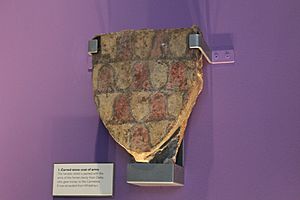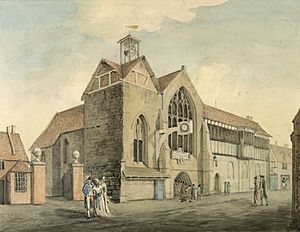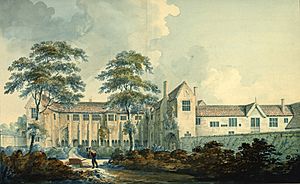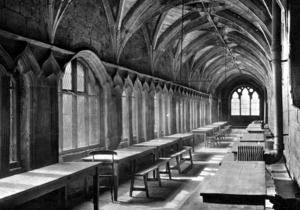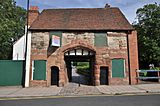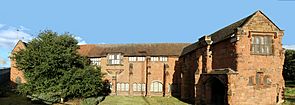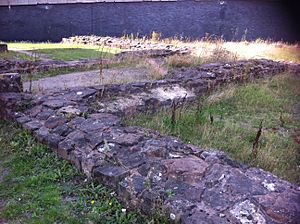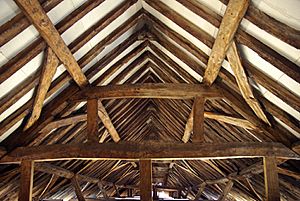Whitefriars, Coventry facts for kids
Quick facts for kids Whitefriars |
|
|---|---|
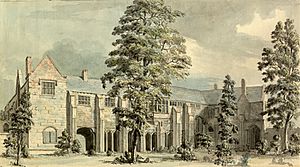
Whitefriars c. 1776, as painted by Moses Griffith.
|
|
| General information | |
| Type | Friary |
| Town or city | Coventry |
| Country | England |
| Coordinates | 52°24′18″N 1°30′05″W / 52.40502°N 1.50148°W |
| Current tenants | Herbert Art Gallery and Museum |
| Opened | 14 February 1342 |
| Renovated | 1965 |
| Owner | Coventry City Council |
| Technical details | |
| Floor count | 2 |
Whitefriars refers to the old buildings that are left from a Carmelite friary. A friary is a place where a group of religious men called friars lived and worked. This one was started in 1342 in Coventry, England.
Today, only a few parts remain. These include the eastern part of the cloister (a covered walkway), a special gate on Much Park Street, and the old church's foundations.
Whitefriars was a friary until the dissolution of the monasteries, when King Henry VIII closed many religious houses. Later, in the 1500s, it was owned by John Hales. For a while, it was home to King Henry VIII School, Coventry. In the 1800s, it became a workhouse, a place where poor people lived and worked.
Now, the buildings are used by the Herbert Art Gallery and Museum, Coventry. The remaining cloister walk is made of red sandstone. Its wooden roof is not the original, but it was likely moved from another building in the 1500s.
Only a small part of the original buildings still stands. The old gateway was even used as a toy museum until 2008! Some places in Coventry, like the Whitefriars Ale House and Whitefriars Housing Group, are named after this historic site.
Contents
History of Whitefriars
How Whitefriars Started
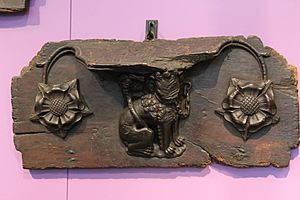
The friary began on February 14, 1342. Sir John Poultney helped to set it up. It was built on land that used to be fields and fruit orchards.
The Carmelites were a religious group known as mendicant friars. This means they relied on kindness from others. They got help from people they taught and from pilgrims visiting their special shrine. This shrine was called Our Lady of the Tower.
In 1344, King Edward III gave land to make the buildings bigger. Another grant followed in 1352. Many local people also gave money to the friary. For example, in 1384, Lord Basset of Drayton gave money to make the church larger. In 1419, William Botener helped to expand the monastery. Later, in 1506, Thomas Bonde of Coventry gave money for rebuilding the cloisters.
During digs at the church, a shield with the Ferrers family coat of arms was found. This suggests that the Ferrers family also donated to the friary. Carmelite friaries depended on these gifts to build their homes. The Coventry friary grew over time as more money became available.
The church was dedicated to the Virgin Mary. It was one of the longest friary churches in England and one of the first buildings on the site. Like the rest of Whitefriars, the church was made from red sandstone blocks. Its inside walls were painted white with fancy stone decorations. The floor had patterned clay tiles made nearby. The wooden seats in the choir were beautifully carved. Some of these carvings, called misericords, survived and were later moved to the Old Grammar School.
Whitefriars in Tudor Times
Whitefriars closed on October 1, 1538. This was part of King Henry VIII's plan to close down monasteries in England. The 14 friars living there signed papers to give up the friary.
In 1544, the King gave the friary to Sir Ralph Sadler. He then sold it to John Hales. Hales had bought many former monastery properties in Coventry. He tore down some parts of Whitefriars. He turned part of the cloister into his home, calling it Hales Place. He also used the chancel (part of the church) as a grammar school. The choir stalls became seats for the students.
In 1545, John Hales started King Henry VIII School, Coventry. It was a free grammar school. He paid for it himself, giving the school master a very good salary.
When Queen Mary ruled (1553–1558), John Hales, who was a Protestant, left England because of his religious beliefs. While he was away, the Coventry Corporation moved the school. It went from Whitefriars church to the Hospital of St. John the Baptist. They also claimed the church as a local church.
It is believed that a secret printing press was hidden at the friary while Hales was abroad. Even though he said he didn't know about it, he was fined a lot of money.
Queen Elizabeth I's Visit
In August 1565, Queen Elizabeth I visited Coventry. She stayed for two days at Whitefriars with John Hales. She called it a "fine house." Later, from November 1569 to January 1570, Mary Queen of Scots was held in Coventry by Elizabeth's orders. She spent some of this time at Whitefriars.
John Hales died in 1572. His nephew, John Hales II, inherited his properties. The Hales family moved to a new house in Coventry. They rented Whitefriars to Lord Henry Berkeley of Caludon Castle.
Whitefriars in Later Years
The building changed owners several times. In 1801, it was sold and turned into a workhouse. People living there worked long hours, 12 hours in winter and 13 in summer. They only had short breaks for meals. Young children got a basic education at the workhouse school. In 1906, a special block for children was added.
The cloister building was damaged during a bombing raid in 1940. In 1948, it became a Salvation Army hostel. After a big restoration in 1965, it opened as "Whitefriars Museum" in 1970. The dormitory was an exhibition hall. It showed the building's history as a friary, a private home, and a workhouse. The museum closed in the early 1990s due to budget cuts.
Today, the Herbert Art Gallery and Museum owns the building. It is usually not open to the public, except on special Heritage Open Days.
Whitefriars Gate, which is a bit away from the main building, was bought in 1973 by Ron Morgan. He used it as the Coventry Toy Museum. It closed in 2008 after he passed away. In 2009, the gate was damaged by a fire, but it still stands.
Only Whitefriars Gate on Much Park Street and the cloister wing are left from the 14th-century monastery.
Architecture of Whitefriars
When it was founded in 1342, Whitefriars covered about 10 acres (4 ha) in southeast Coventry. You would enter from Much Park Street, where an outer gate still stands. The cloister building was built from red sandstone.
The cloister walk that remains is the eastern part. Originally, there were four such walks forming a square courtyard. This remaining cloister is much like it was when first built. The windows used to have no bars and looked out onto a garden. You can still see marks on one wall where wooden benches and tables were attached in the 1800s, when it was a workhouse.
Halfway along the cloister walk, there's an opening to the chapter house vestibule. This was once a long entrance arch. The window in the chapter house was moved from another part of the friary after it was torn down. On each side of the vestibule, there's a room. One was the "friars' warming room" with a fireplace. The other was their parlour, used for meetings and talking. When it was a workhouse, this room served as a chapel.
The dormitory is on the upper floor. This is where the friars worked and slept. At the north end, a "night stair" led down to the church, which is now gone. A blocked-up doorway on the opposite wall led to a room above the vestry. You can still see the foundations of the vestry outside.
After John Hales bought Whitefriars in 1544, he added a fireplace and a special "Oriel window" to the dormitory. This was the room where Queen Elizabeth I was entertained during her visit in the 1560s.
The windows and ceilings in the cloister and chapter house show amazing medieval stonework. The ceiling has stone ribs that form arches, filled in with stone blocks. There are also decorative carved faces where the arched ribs come out of the walls.
The wooden roof of the building is probably not the original. It's from the 1500s and was made locally. It was likely brought from another similar building that John Hales also bought after the monasteries were closed.
Whitefriars' Local Influence
Like the Greyfriars monastery in Coventry, Whitefriars has given its name to local places and businesses. The Whitefriars Ale House, a historic building, was named after the monastery because it was within its old boundaries. It is next to Whitefriars Lane, which goes through Whitefriars Gate.
The Whitefriars Housing Group, based in Coventry, was also named after the friary.


